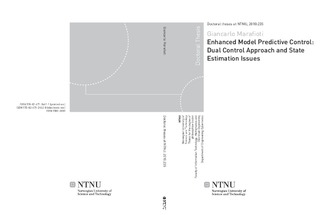| dc.contributor.author | Marafioti, Giancarlo | nb_NO |
| dc.date.accessioned | 2014-12-19T14:03:21Z | |
| dc.date.available | 2014-12-19T14:03:21Z | |
| dc.date.created | 2010-12-17 | nb_NO |
| dc.date.issued | 2010 | nb_NO |
| dc.identifier | 379307 | nb_NO |
| dc.identifier.isbn | 978-82-471-2461-1 (printed version) | nb_NO |
| dc.identifier.isbn | 978-82-471-2462-8 (electronic version) | nb_NO |
| dc.identifier.uri | http://hdl.handle.net/11250/260260 | |
| dc.description.abstract | The main contribution of this thesis is the advancement of Model Predictive Control (MPC). MPC is a well known and widely used advanced control technique, which is model-based and capable of handling both input and state/output constraints via receding horizon optimization methods. The complex structure of MPC is delineated, and it is shown how improvements of some of its components are able to enhance overall MPC performance.
In more detail, in Chapter 3, the definition of a state dependent input weight, in the cost function, shows satisfactory controller performance for a large region of working conditions, compared to a standard MPC formulation. The robustness of the optimization problem is improved, i.e., this particular weight configuration yields a ‘better’ conditioned problem than the standard MPC will produce. This is demonstrated by a simulation study of a particular Autonomous Underwater Vehicle.
Chapter 4 presents a novel formulation named Persistently Exciting Model Predictive Control (PE-MPC). The fundamental idea is that because of its use of a model, MPC should be amenable to adaptive implementation and on-line tuning of the model. Such an approach requires guaranteeing certain signal properties, known as ‘persistent excitation’, to ensure uniform identifiability of the model. An approach to augment the input constraint set of MPC to provide this guarantee is proposed. It is also shown, how this formulation has properties that are typical of Dual Control problems. Theoretical results are proven and simulation-based examples are used to confirm the strength of this new approach.
Chapter 5 takes state estimation issues into account. Kalman filtering for nonlinear systems is described, and throughout the chapter, a comparison of the more recent Unscented Kalman Filter (UKF), with the well known Extended Kalman Filter (EKF) is given. Two examples are presented, first a photobioreactor for algae production, and then a simple but effective example of locally weakly unobservable nonlinear system. In both cases, simulation-based results prove the advantages of using UKF as an alternative to EKF. | nb_NO |
| dc.language | eng | nb_NO |
| dc.publisher | Norges teknisk-naturvitenskapelige universitet, Fakultet for informasjonsteknologi, matematikk og elektroteknikk, Institutt for teknisk kybernetikk | nb_NO |
| dc.relation.ispartofseries | Doktoravhandlinger ved NTNU, 1503-8181; 2010:235 | nb_NO |
| dc.title | Enhanced Model Predictive Control:Dual Control Approach and State Estimation Issues | nb_NO |
| dc.type | Doctoral thesis | nb_NO |
| dc.contributor.department | Norges teknisk-naturvitenskapelige universitet, Fakultet for informasjonsteknologi, matematikk og elektroteknikk, Institutt for teknisk kybernetikk | nb_NO |
| dc.description.degree | PhD i Teknisk kybernetikk | nb_NO |
| dc.description.degree | PhD in Engineering Cybernetics | en_GB |
